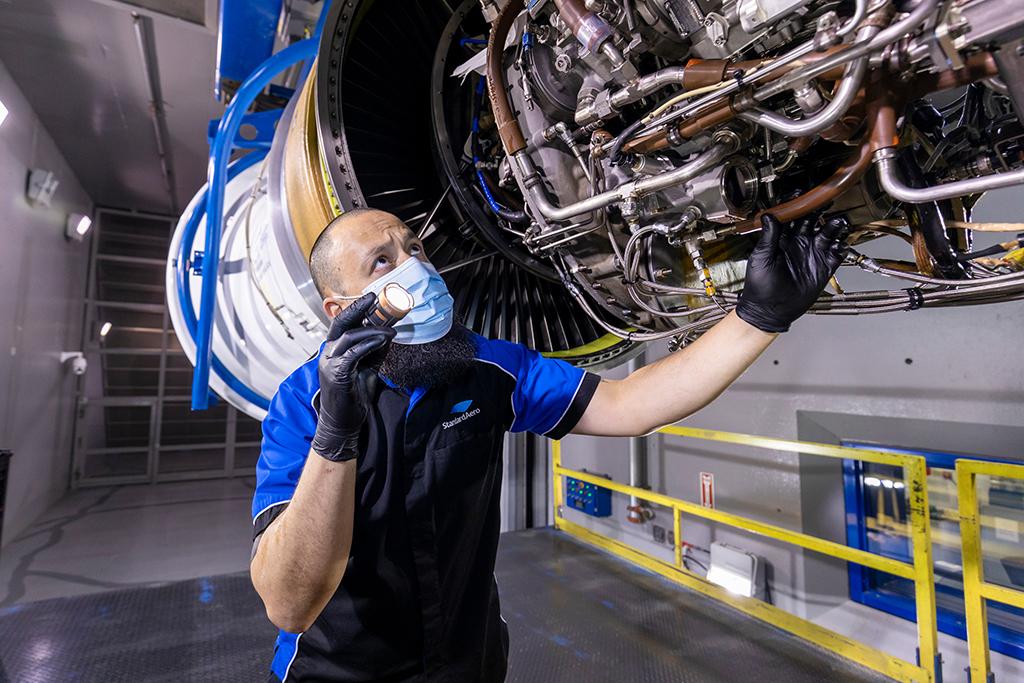Embraer’s 175 Gets Confidence Boost As Future Looks Steady

As airline pilot contractual scope clauses show no signs of changing in the critical North American market, a future for Embraer’s popular 76-seat E175 is all but assured.
“Ongoing U.S. mainlines’ scope clauses are not expected to change in the next three years, and Embraer will keep monitoring the next round of scope-clause negotiations when such restrictions may be revisited,” says Daniel Galhardo, strategic marketing director for Embraer Commercial Aircraft. “Until then, the current-generation E175 jet will continue to be the best solution available to this market segment.”
The scope clause, part of the current labor contract between pilots and major airlines in the U.S., restricts any aircraft operated by their regional air carrier partners to a limit of 76 passengers and an 86,000-lb. maximum takeoff weight.
Embraer, Galhardo adds, will offer the aircraft as long as the market demands, although the E175-E2, targeted for entry into service in 2027-28, could replace it. “The E175 will continue to be offered at least until then, although nothing stops it being commercialized even further,” Galhardo remarks.

The E175 initially entered service with Air Canada in July 2005 and gained U.S. certification in September 2005; there are now 650 E175s in the global fleet, 601 of which—90%—are in the U.S. market, according to Embraer. It is the only new-production regional jet that meets U.S. airline scope-clause requirements in both maximum seat count and takeoff weight, says Adam Guthorn, managing director of Alton Aviation Consultancy.
Citing Embraer’s first-quarter 2022 deliveries report, Guthorn says Embraer reported a firm-order backlog of 143 E175s. “Earlier this year, Embraer delayed the target entry into service for the E175-E2, which will directly replace the E1 variant, until 2027-28. This indicates significantly more life in the E175-E1 program,” he says. “Also, the E175-E2 exceeds the current scope-clause weight limits.”
As for the possibility that Embraer might build on the E175’s success and offer it as a passenger-to-freighter (P2F) aircraft, as it recently announced for the larger E190/195, Guthorn says it is unlikely. “The E175 continues to have significant demand from U.S. regionals, with no immediate replacement,” he says. “Further, there are challenges with fitting a cargo door forward of the engines due to the shorter fuselage of the E175.”
Embraer’s Galhardo, on the other hand, is somewhat more optimistic. “Currently, there are no plans for a P2F E175 conversion program, but that can be considered if demand shows up,” he says.
In a further vote of confidence in the future of the E175, longtime customer Alaska Air Group announced at this year’s Farnborough International Airshow an order for eight more of the aircraft plus options for an additional 13. Including options, the contract value is $1.12 billion, based on the manufacturer’s list price. Deliveries are slated to begin in the second quarter of 2023 to Horizon Air, the Alaska Air Group’s wholly owned regional airline subsidiary, which inducted its first E175s in 2017. Horizon operates 30 E175s now and is scheduled to take delivery of another 20 by 2026.
Nat Pieper, Alaska Air Group’s senior vice president of fleet, finance and alliances, reports that the expanding E175 fleet, which includes three deliveries this year, will enable Horizon to phase out its Bombardier Q400 turboprop fleet by the end of this year.
“The E175 will be the Alaska Air Group’s sole regional airliner,” Pieper says. “While the economics favor the Q400 on routes up to 350 mi., the greater efficiencies of a single fleet type—reduced spares, a better [customer] experience, and premium and first-class yields—outweigh any economic advantage of the Q400 over the E175 on short stage lengths.”
Pieper notes that the E175’s stage lengths average 471 mi., while the daily utilization rate is 8.8 hr. That number includes those operated by Horizon Air for sister company Alaska Airlines as well as those operated for Alaska Airlines by its SkyWest partner.

The E175, Pieper explains, offers the same three-class cabin as Alaska Airlines’ Boeing 737 fleet. “The E175s have developed markets to the point of requiring the 737’s higher capacity and, at the same time, providing added frequencies in the same 737 markets,” he says.
Asked about OEM support, Pieper says that Embraer has done “an admirable” job. “I would say that they have gotten better at it,” he says. “As with everyone, it has had its supply chain challenges, but they have been very proactive in working with their suppliers. They are much more responsive than they were two years ago.”
The E175 fleet outlook and MRO market are projected to remain reasonably strong between now and 2031, according to data from Aviation Week’s 2022 Commercial Fleet and MRO Forecast. The forecast predicts 628 E175s will be in service this year, generating $1.1 billion in total MRO demand. By 2031, the global fleet is projected to number 503, but with MRO demand slightly higher at $1.3 billion. The lion’s share of the E175 aftermarket support will be for engines and components, at 51% and 25% in 2022, respectively, and 66% and 17% in 2031, respectively. MROs that service the E175’s GE CF34-8E engines and the aircraft’s components are bullish on the aftermarket outlook.
“We see a near-term spike in demand for CF34-8E MRO, as operators catch up with maintenance deferred during the pandemic for reasons of cost avoidance, but the longer-term picture is more stable,” says Kristjana Werboweski, sales manager for North America at Standard-Aero’s Airlines and Fleets division. She says this is due to several factors, including projections that E175-E1 deliveries will continue for many years.

“Embraer, itself, is projecting demand for 500 new E175s over the next decade in North America alone, due in part to current scope-clause agreements, representing a barrier to entry for the newer Pratt & Whitney GTF-powered E175-E2,” Werboweski says. “On the flip side, since demand for CF34-8E maintenance did not contract as significantly as for other engines during the pandemic, the rebound in demand will not be so great.”
“We are expecting high demand between 2023 and 2026 for scheduled performance restorations, or [life limited part (LLP)] shop visits for the entire CF34-8 series as well as the -10E,” says Raimund Schnell, vice president of marketing and sales at Lufthansa Technik AERO Alzey (LTAA). “Since most of the regional airlines postponed scheduled shop visits during the pandemic, we are currently faced with a frequent increase of unscheduled shop visits.”
Stressing that LTAA is well prepared, Schnell cautions that available shop visit slots are getting fewer and additional factors such as supply chain issues may worsen the situation. “Our recommendation is to communicate engine removal plans at least 12-15 months in advance, which is very important for shop visits driven by LLP replacements.”
Schnell adds that LTAA is seeing increased LLP lead times, which he attributes to material and staffing issues. “We can’t completely rule out further delays due to worsening material bottlenecks, such as titanium,” he says.
Taco Stouten, vice president of sales and marketing at Germany-based Spairliners, a specialist in line replaceable units, reports that the company supports more than 1,200 components for the E170/175 and E190/E195.
“We expect that the component aftermarket for the E175—which is 50% of the active Embraer 170/190 fleet—will remain concentrated around the U.S. market,” Stouten says. “These aircraft are relatively young and will continue to fly for at least another decade. For these reasons, Spairliners is targeting the Americas as a place to establish service, and we are quite close to making that a reality.”
Looking ahead, Stouten predicts that as these aircraft age, they will move to parts of the world where labor costs are lower. “The flight hours for in-service aircraft in those regions are significantly lower, which will help the longevity of the E175,” he says.






